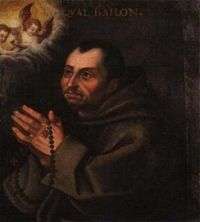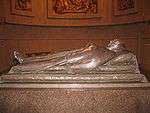Paschal Baylon
| Saint Paschal Baylon | |
|---|---|
 | |
| "Seraph of the Eucharist" | |
| Born |
1540 Torrehermosa, Aragon |
| Died | 17 May 1592 |
| Venerated in | Roman Catholicism |
| Beatified | 1618 by Paul V |
| Canonized | October 16, 1690 by Alexander VIII |
| Major shrine | Royal Chapel in Vila-real |
| Feast | May 17 |
| Attributes | Monstrance, Franciscan habit |
| Patronage | Patron of Eucharistic congresses and Eucharistic associations, Obando, Bulacan |
Saint Paschal Baylon (also Pascal or Pascual, 16 May 1540 – 17 May 1592) was a Spanish friar and is a saint in the Roman Catholic Church. He is the patron saint of Eucharistic congresses and Eucharistic associations.
Life
He was born at Torrehermosa, in the Kingdom of Aragon, on 16 May 1540, on the Feast of Pentecost, called in Spain "the Pasch (or "Passover") of the Holy Ghost", hence the name Paschal. His parents, Martin Baylon and Elizabeth Jubera, were poor peasants. He spent his youth as a shepherd.[1] He would carry a book with him and beg passersby to teach him the alphabet and to read, and as he toiled in the fields he would read religious books.
In around 1564, he joined the Reformed Franciscan Order (Alcantarine Reform) as a lay brother. He chose to live in poor monasteries because, he said, "I was born poor and am resolved to die in poverty and penance." He lived a life of poverty and prayer, even praying while working, for the rest of his life.
He was a mystic and contemplative, and he had frequent ecstatic visions. He would spend the night before the altar in prayer many nights. At the same time, he sought to downplay any glory that might come from this piety. He died on 17 May, which is his current feast day, in 1592.
Veneration

His tomb in the Royal Chapel in Vila-real in the old province of Valencia, where he died, immediately became an object of pilgrimage. Beatified by Paul V in 1618, he was canonized by Alexander VIII on 16 October 1690. The saint is usually depicted in adoration before a vision of the Eucharist.
Forty years before he was canonized, an indigenous Guatemalan claimed to have had a vision of a sainted Paschal Baylon, appearing as a robed skeleton. This event became the basis of the heterodox tradition of San Pascualito.[2]
Paschal Baylon was enlisted in the Church's struggle against Modernism, part of which was through increasing devotion towards the Sacrament of the Eucharist; Pope Leo XIII[3] proclaimed Saint Paschal Baylon, the "seraph of the Eucharist", patron of eucharistic congresses, and all contemporary and future eucharistic associations. Christian art usually depicts him wearing the Franciscan habit and bearing a monstrance, signifying his devotion to the Holy Eucharist.
During the Red Terror at the time of the Spanish Civil War (1936-1939), his grave was desecrated and his relics burned by anticlerical leftists.[4]
Patronage
- St Paschal Library,[5] Box Hill, Victoria, Australia
- Town of Saint-Pascal, Quebec
See also
Notes
- ↑ Foley, Leonard. "St. Pascal Baylon", Saint of the Day, Franciscan Media
- ↑ Feldman, Lawrence H. (1999). The War Against Epidemics in Colonial Guatemala, 1519-1821. C&M Online Media, Inc. pp. 23–27. ISBN 1-886420-60-2.
- ↑ in the Apostolic Brief Providentissimus Deus, November 28, 1897
- ↑ Butler, Alban, David Hugh Farmer and Paul Burns Butler's Lives of the Saints p. 93 (1997 Continuum International Publishing Group) ISBN 0-86012-254-9
- ↑ "Home - St Paschal Library". www.vspc-franciscan.org.au. Retrieved 2016-02-09.
External links
| Wikimedia Commons has media related to Paschal Baylon. |